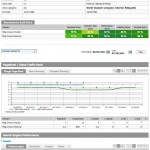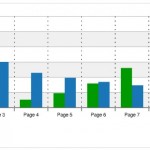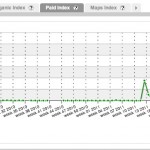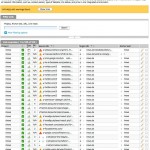 Despite what some may think, SEO is hard manual labor rather than simple magic, and proper preparation and follow-up assessment are an important part of professional Google optimization work. Today’s enterprise SEOs see themselves more as project managers than independent artists, and rely on detailed data and figures rather than tea-leaf fortune telling. In this small series, I will try to offer some assistance and describe some common workflows and processes that have proven themselves in a professional SEO environment.
Despite what some may think, SEO is hard manual labor rather than simple magic, and proper preparation and follow-up assessment are an important part of professional Google optimization work. Today’s enterprise SEOs see themselves more as project managers than independent artists, and rely on detailed data and figures rather than tea-leaf fortune telling. In this small series, I will try to offer some assistance and describe some common workflows and processes that have proven themselves in a professional SEO environment.
Defining different workflows
Each job should be repeated with a specific frequency determined by its scale, available data and urgency. For example, it is not particularly sensible to scan an entire website for technical optimization possibilities every day. But, anyone who doesn’t look at their SERP spreading each weak will have no one else to blame when they fail to recognize a penalty early on.
Therefore, we recommend that our clients employ at least three different ‘workflows’ with differing frequency and with different tasks and goals. I will use this short series to briefly sketch these three SEO workflows. And, because we recommend the use of the Searchmetrics Suite in enterprise SEO, I will document the necessary steps using graphs and figures from this tool.
The ‘Weekly Workload’: Quick checks, co-operative instructions and work monitoring
Since Google optimization is more than just reading and interpreting figures and reports, we recommend that our clients focus their weekly tasks to make them highly operational and practical. Search engines sometimes react quite quickly to content development, making it worthwhile to maintain frequent updates. Your colleagues in editorial, product and project management will also be grateful for weekly directives – people want to know what they should be working on.
The following reports and tasks have been proven for weekly use:
1. SEO Dashboard of your sites and your competitors’:

You should force yourself to put your finger on a site’s pulse once a week:
- How has the number of pages in the index changed?
- Has there been a lot of Social Media impact?
- Where are we with PageRanks?
- etc…
Essentially you should check the domain details for your own domain once a week, and those of the strongest competitors as well.
Of course, you can always have these data sent to you via reports. But be careful – will they really be seen? I’m of the opinion that setting aside a regular weekly time to dive into the tool will do you good.
2. Weekly keywords at the category level:

Anyone monitoring several hundred or thousand keywords can probably barely manage to flip through them once per week. Therefore we recommend that you firstly categorize your keywords. Then, you can at least tell with a quick look whether the long tail is ‘greased-up’, or if your top keywords have a problem. Second, we recommend that a few really important keywords be included in the so-called ‘graph’. This will ensure that they are displayed in the Keyword Overview together with their historical data. Then, all it takes is a glance to know whether everything is working well or if things are getting hectic.
3. Movers & Shakers from the Quick Analysis

There is often a lot of potential even in unmonitored keywords – and sometimes a lot of movement too.
Here, it is important not to fall in love with the details but to look for the largest possible levers and, through good knowledge of a site, to discover completely new and well positioned sectors. Anyone looking at the list of Movers & Shakers from Spiegel Online will find a surprisingly high proportion of attractive threshold keywords, also called ‘cliffhangers’ like “game” at 12th position or “google mail” at number 8. In contrast “internet explorer” has already eandered into the topic pages – a sensible path with good optimization.
Remember – in enterprise SEO it’s usually not about the individual keyword but everything that comes with it.
4. SERP Spreading:

This graph shows the distribution of identified keywords from the first ten Google search result pages. This value has two important functions. First, you can naturally see whether you have ‘arrived’ on the highly sought-after first page of search results and how your efforts have had an impact.
Second, SERP spreading has a warning function. If you compare results to the previous week and see that a bump has appeared somewhere around the sixth page in then this points a penalty from Google. If this occurs, then you should look directly for the directory or subdomain that has incurred the punishment.
And just because it looks better, we have included the SERP spreading of two US sites: The New York Times vs. Suite101. One of these sites slipped after the Panda Update. Which one do you think it was?
5. Discover opportunities and additional tasks:
Things become very practical and operational when it comes to possible opportunities. This is for worthwhile keywords that we have pushed to an already ‘quite good’ position, say somewhere around 12th place.
Because ‘quite good’ still doesn’t bring any traffic to a site, we should look at these page/keyword combinations very closely. If there is a possibility that, with a little onsite optimization and maybe a somewhat improved internal linking, this page can be ‘catapulted’ to the first search results page then of course you should do it. This is why these opportunities need to be put in a table and given to your team together with clear directives.
Here again we have an example from Spiegel Online. In the picture to the right, there are a bunch of very attractive keywords that they might work on to great benefit. ‘Weather’ in 20th position? With a little content and a few links a visible place for Der Spiegel should be theirs for the taking.
And don’t forget, we can only know whether our efforts were successful when we continue to monitor these keywords afterwards…
6. Optimize advertisements and evaluate competitors:

The optimization of SEA measures, i.e. placement of AdWords, should not wait for technical considerations, feedback and the sometimes sluggish search engines. For this reason, I recommend that optimization measures address ads and competitor monitoring weekly using the AdWords tool.
Once again, the Spiegel Online overview offers some interesting details. It comes as no surprise that they have placed an AdWords ad for “premium subscription” or “Der Spiegel”. But “back-to-school gifts”? Then again, maybe it really is a good idea to give school starters an early Spiegel subscription…
7. Other tasks and important checks:

Of course, every site is different and so are its weekly challenges. Anyone undertaking a lot of link building needs to take a look at their link management at least once a week. If it looks like the picture on the right, then you have a problem. There are far too many warnings and instructions that have not been processed. High time to take care of the links on this site…
Also, anyone currently stuck in the middle of a Universal Search project will be able to find their special assignments here. And so on, and so on…
And now the crucial question – how much time does all this need?
The answer comes from the old Armenian Radio – it all depends! Of course it depends on how many pages and keywords you’re looking after. But if the tool is well prepared, you can (theoretically) get all these tasks done in a lazy half hour. There are, however, two possible situation for which this time will not be sufficient:
1. When an alert from you digital ‘patrol’ requires a more detailed analysis of your monitoring. How come SERP spreading has deteriorated? Are we actually ‘greased-up’ with our longtail keywords? How come so many opportunities come under the category “XY”. It is important to answer each of these questions when they arise. But of course this takes times.
2. Apart from this we are Google optimizers and therefore have a natural curiosity. It is rarely the case that someone checks the SEO figures for their site and in doing doesn’t also throw a look once more at their competitors’ SERPS, or perhaps begin or look over a quick keyword research project to see whether the changes in ranking factors can be checked with some figures or data… This of course takes time too. But it’s also a good reason for why we are SEOs.
P.S.: Who’s writing this stuff? My name is Eric Kubitz and I am one of the co-founders of CONTENTmanufaktur GmbH [fuzzy] Anyone trying to reach me can do so via e-mail (ek@contentmanufaktur.net), Twitter, or G+… ‘Til next time!